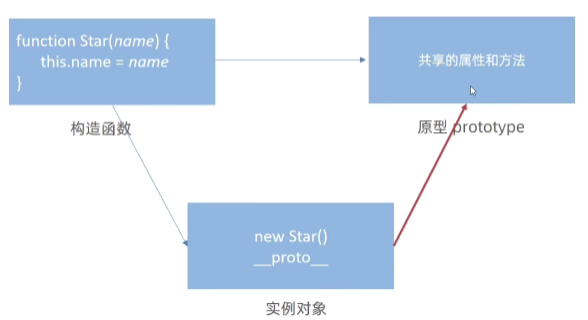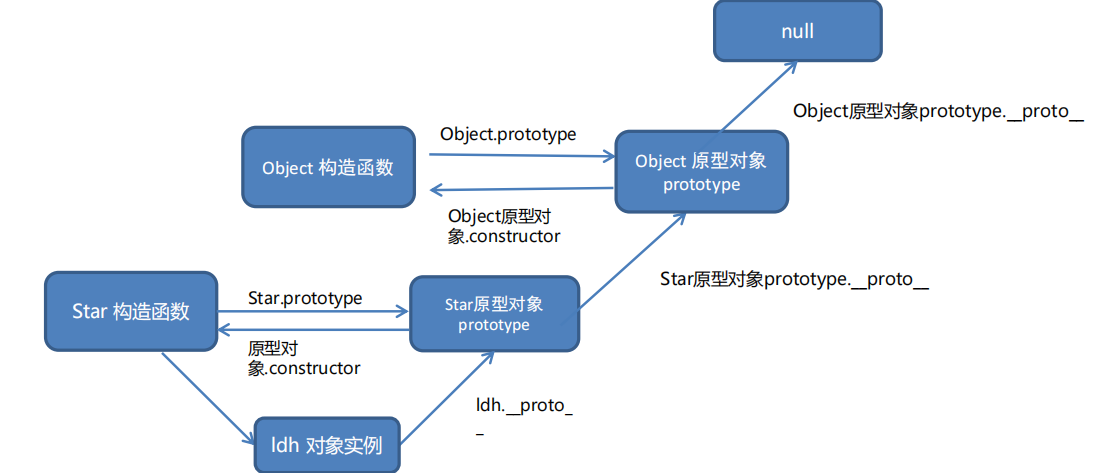原型对象
所有的函数都有一个prototype属性。当一个函数被用作构造函数来创建新对象时,新创建的对象会从构造函数的prototype属性上继承属性和方法。
- JavaScript 规定,每一个构造函数都有一个 prototype 属性,指向另一个对象,所以我们也称为原型对象
- 这个对象可以挂载函数,对象实例化不会多次创建原型上函数,节约内存
- 我们可以把那些不变的方法,直接定义在 prototype 对象上,这样所有对象的实例就可以共享这些方法。
- 构造函数和原型对象中的this 都指向 实例化的对象
查看原型对象:
<script>
function Person() {
}
// 每个函数都有 prototype 属性
console.log(Person.prototype)
</script>构造函数 Person 中定义与原型对象中相同名称的方法,这时实例对象调用则是构造函中的方法 sayHi。
通过以上两个简单示例不难发现 JavaScript 中对象的工作机制:当访问对象的属性或方法时,先在当前实例对象是查找,然后再去原型对象查找,并且原型对象被所有实例共享。
<script>
function Person() {
// 此处定义同名方法 sayHi
this.sayHi = function () {
console.log('嗨!');
}
}
// 为构造函数的原型对象添加方法
Person.prototype.sayHi = function () {
console.log('Hi~');
}
let p1 = new Person();
p1.sayHi(); // 输出结果为 嗨!
</script>prototype属性用法:
<script>
function Person() {
this.name = name
this.age = age
}
// 为构造函数的原型对象添加方法
Person.prototype.sing = function() {
console.log('我会唱歌')
}
// 实例对像,获得了构造函数中封装的所有逻辑
let p1 = new Person('刘德华', 50)
let p2 = new Person('张学友', 55)
console.log(p1.sing === p2.sing) // true
</script>结合构造函数原型的特征,实际开发重往往会将封装的功能函数添加到原型对象中。
数组扩展封装案例
<script>
// 封装最大值方法
Array.prototype.max = function () {
return Math.max(...this)
}
// 封装最小值方法
Array.prototype.min = function () {
return Math.min(...this)
}
// 封装求和方法
Array.prototype.sum = function () {
return this.reduce((prev, item) => prev + item, 0)
}
let arr = [6, 4, 10]
console.log(arr.max()) // 10
console.log(arr.min()) // 4
console.log(arr.sum()) // 20
</script>constructor 属性
每个原型对象里面都有个constructor 属性。
作用:该属性指向该原型对象的构造函数。
function Star() {}
console.log(Star.prototype.constructor === Star) // true使用场景:
如果有多个对象的方法,我们可以给原型对象采取对象形式赋值。
但是这样就会覆盖构造函数原型对象原来的内容,这样修改后的原型对象 constructor 就不再指向当前构造函数了
此时,我们可以在修改后的原型对象中,添加一个 constructor 指向原来的构造函数。
function Star() {}
// 通过赋值形式同时添加多个共享方法,会覆盖原对象
Star.prototype = {
// 添加constructor属性
constructor: Star,
sing: function() {
console.log('唱歌')
},
dance: function() {
console.log('跳舞')
}
}对象原型
对象都会有一个属性 __proto__ 指向构造函数的 prototype 原型对象,之所以我们对象可以使用构造函数 prototype 原型对象的属性和方法,就是因为对象有 __proto__ 原型的存在。
注意:
__proto__是JS非标准属性,有时候浏览器显示[[prototype]][[prototype]]和__proto__意义一样,只读属性- 用来表明当前实例对象指向哪个原型对象prototype
__proto__对象原型里面也有一个 constructor属性,指向创建该实例对象的构造函数

原型继承
继承是面向对象编程的另一个特征,通过继承进一步提升代码封装的程度,JavaScript 中大多是借助原型对象实现继承的特性。
龙生龙、凤生凤、老鼠的儿子会打洞描述的正是继承的含义。
<body>
<script>
// 继续抽取 公共的部分放到原型上
// const Person1 = {
// eyes: 2,
// head: 1
// }
// const Person2 = {
// eyes: 2,
// head: 1
// }
// 构造函数 new 出来的对象 结构一样,但是对象不一样
function Person() {
this.eyes = 2
this.head = 1
}
// console.log(new Person)
// 女人 构造函数 继承 想要 继承 Person
function Woman() {
}
// Woman 通过原型来继承 Person
// 父构造函数(父类) 子构造函数(子类)
// 子类的原型 = new 父类
Woman.prototype = new Person() // {eyes: 2, head: 1}
// 指回原来的构造函数
Woman.prototype.constructor = Woman
// 给女人添加一个方法 生孩子
Woman.prototype.baby = function () {
console.log('宝贝')
}
const red = new Woman()
console.log(red)
// console.log(Woman.prototype)
// 男人 构造函数 继承 想要 继承 Person
function Man() {
}
// 通过 原型继承 Person
Man.prototype = new Person()
Man.prototype.constructor = Man
const pink = new Man()
console.log(pink)
</script>
</body>原型链
基于原型对象的继承使得不同构造函数的原型对象关联在一起,并且这种关联的关系是一种链状的结构,我们将原型对象的链状结构关系称为原型链。

<body>
<script>
// function Objetc() {}
console.log(Object.prototype)
console.log(Object.prototype.__proto__)
function Person() {
}
const ldh = new Person()
// console.log(ldh.__proto__ === Person.prototype)
// console.log(Person.prototype.__proto__ === Object.prototype)
console.log(ldh instanceof Person)
console.log(ldh instanceof Object)
console.log(ldh instanceof Array)
console.log([1, 2, 3] instanceof Array)
console.log(Array instanceof Object)
</script>
</body>① 当访问一个对象的属性(包括方法)时,首先查找这个对象自身有没有该属性。
② 如果没有就查找它的原型(也就是 __proto__指向的 prototype 原型对象)
③ 如果还没有就查找原型对象的原型(Object的原型对象)
④ 依此类推一直找到 Object 为止(null)
⑤ __proto__对象原型的意义就在于为对象成员查找机制提供一个方向,或者说一条路线
⑥ 可以使用 instanceof 运算符用于检测构造函数的 prototype 属性是否出现在某个实例对象的原型链上
